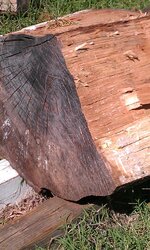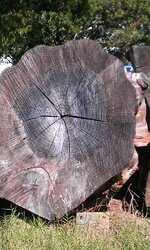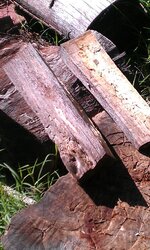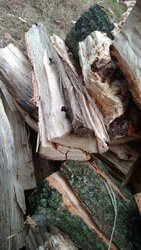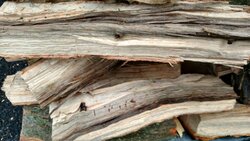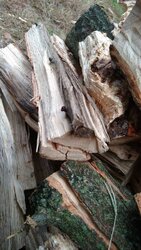Unless you guys reassure me to the contrary, I have some very unfortunate news about some of my firewood.
I took a Oak tree down in February 2016. Radius about 2 to 3 feet at the ground level so a good-sized tree. There was no problem with the tree at all, the homeowner just wanted it down, it was definitely alive and healthy looking before it lost the leaves in November and so you have to assume in February as well.
I processed all the limbs that didn't require too much splitting. Everything went as planned. The huge trunk was cut off in 12 to 16 inches lengths, kept off the ground, air between each piece, very much in the sun, can't remember if I covered them but I probably did until spring came along. Keeping my eye on them over the months everything look just fine. I like to split a little bit every few days for some exercise so I finally got around to these bigger trunk pieces a few weeks ago so about eight months from the time we took down that green tree and February 2016.
Turns out the outer probably 40-60% appears rotted. Looking carefully, I do see a different color in this outer perimeter. So the innermost 30-40% is non-rotted normal would when I split it. It's not even worth the effort to go after that good 30%. I think I will trash it all, what a shame, what a waste. Just for my verification, I am going to take a couple of pieces with obvious rot and burn them outside just to be sure but I don't think that's going to change my opinion that it's rotted. And I do see some mushrooms on the outside in addition to that discoloration- mushrooms mean riding right?
I've been doing this for decades, this never happened to me. Has anyone else experienced this? I have to believe that there was already some type of fungus on/in the tree and then it just took off. But I'm telling you when we cut this tree down it was all solid/green.
All comments appreciated.
I took a Oak tree down in February 2016. Radius about 2 to 3 feet at the ground level so a good-sized tree. There was no problem with the tree at all, the homeowner just wanted it down, it was definitely alive and healthy looking before it lost the leaves in November and so you have to assume in February as well.
I processed all the limbs that didn't require too much splitting. Everything went as planned. The huge trunk was cut off in 12 to 16 inches lengths, kept off the ground, air between each piece, very much in the sun, can't remember if I covered them but I probably did until spring came along. Keeping my eye on them over the months everything look just fine. I like to split a little bit every few days for some exercise so I finally got around to these bigger trunk pieces a few weeks ago so about eight months from the time we took down that green tree and February 2016.
Turns out the outer probably 40-60% appears rotted. Looking carefully, I do see a different color in this outer perimeter. So the innermost 30-40% is non-rotted normal would when I split it. It's not even worth the effort to go after that good 30%. I think I will trash it all, what a shame, what a waste. Just for my verification, I am going to take a couple of pieces with obvious rot and burn them outside just to be sure but I don't think that's going to change my opinion that it's rotted. And I do see some mushrooms on the outside in addition to that discoloration- mushrooms mean riding right?
I've been doing this for decades, this never happened to me. Has anyone else experienced this? I have to believe that there was already some type of fungus on/in the tree and then it just took off. But I'm telling you when we cut this tree down it was all solid/green.
All comments appreciated.


